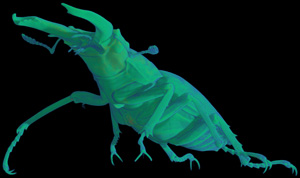Lucanus, the staghorn beetle, is a charismatic member of the beetle group Lucanidae, and it has captured the imagination of many naturalists. In fact, Lucanus is the subject of the oldest European painting from which a beetle can be identified to species (painting by Albrecht Durer in 1505; Crowson, 1981). Over 1,000 species of lucanids are found globally, of which approximately 30 species in 10 genera inhabit the United States (Arnett, 1960). Lucanus elephus, the largest species in North America, can reach 6 cm in length (Staines, 2001).
Lucanids are easily identifiable by their enlarged, toothed mandibles. The mandibles are present in both males and females, although the elements are larger in males. Size of the mandible is positively correlated to body size (Crowson, 1981; Tatsuta et al., 2001), and morphology of the element is the focus of most systematic treatments of Lucanidae. Although great morphological diversity of mandibles has been observed among lucanids (Clark, 1977; Kawano, 2000), Huxley (1931) demonstrated that various forms recognized as separate species are merely different growth stages within a species.
The antennae of lucanids are composed of 10 segments, and their morphology is described as geniculate, signifying that the second segment forms an obtuse angle with the first. Each antenna ends in a pectinate club; however, the terminal segments of the antennae cannot be closed as is observed in Scarabaeidae, a clade that is closely allied to Lucanidae (Arnett, 1960). Lucanids are further characterized by toothed tibiae, single claws with two bristles, and five trasals on each appendage.
The larvae of Lucanus possess 4-segmented antennae (Scholtz, 1990), and they typically bore into rotting wood. The adults are often found with the young.
Other beetles on DigiMorph: Nicrophorous americanus
Additional Information on the Morphology of Lucanus
Click on the thumbnails below for labeled images of the specimen in standard anatomical views.

About the Species
About this Specimen
The specimen was scanned along the horizontal axis with an X, Y and Z pixel spacing of 0.0616 mm. It was scanned on a Wälischmiller RayScan 250 E.

About the
Scan
Literature
Arnett, R. H. 1960. The Beetles of the United States: A Manual for Identification. Catholic University of America Press, Washington, D.C. 1112 pp.
Clark, J. T. 1977. Aspects of variation in the stag beetle Lucanus cervus (L.) (Coleoptera: Lucanidae). Systematic Entomology 2:9-16.
Crowson, R A. 1981. The biology of the Coleoptera. Academic Press, London. 802 pp.
Huxley, J. S. 1931. Relative growth of mandibles in stag-beetles (Lucanidae). Journal of the Linnean Society of London, Zoology 37:675-703.
Kawano, K. 2000. Genera and allometry in the stag beetle family, Lucanidae, Coleoptera. Annals of the Entomological Society of America 93:198-207.
Scholtz, C. H. 1990. Phylogenetic trends in the Scarabaeoidea (Coleoptera). Journal of Natural History 24:1027-1066.
Staines, C. L. 2001. Distribution of Lucanus elaphus Linnaeus (Coleoptera: Lucanidae) in North America. The Coleopterists Bulletin 55:397-404.
Tatsuta, H., K. Mizota, and S. Akimoto. 2001. Allometric patterns of heads and genitalia in the stag beetle Lucanus maculifemoratus (Coleoptera: Lucanidae). Annals of the Entomological Society of America 94:462-466.
Links
pictures of staghorn beetles on the Page of the Breeder of Beetles

Literature
& Links
Front page image.
|
 |

Additional
Imagery

